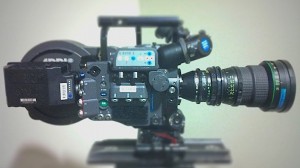Resolution Isn’t Everything: S16/35MM R.I.P. 1891 – 2012
I think its interesting and funny at the same time that companies are now jumping on the 4K bandwagon in regards to cameras, editing and monitoring. We had 4K and 2K for a long time with 16mm and 35mm film. For over 100 years in fact. Its not new, and we have for the most part always been able to screen in 4K via a 35mm film projector. This is how we used to watch movies. So what changed? Why did standard definition and high definition become acceptable? What essentially killed film? I have several theories. The main theory is not cost related, but cost is defiantly a factor for many. Resolution isn’t everything, convenience is. To me it was the VHS tape and DVD that started the death spiral of film. Then home theater, which over the past few decades has become so cheap that almost everyone I know who owns a TV has. Home theater systems used to be uncommon in the mid to late 90’s. You had to spend thousands of dollars just to get a decent sound system with Pro Logic 5.1. Televisions moving from 4:3 to 16×9 aspect ratios to match the movie screen where also unheard of. This wasn’t common place till the past four years. Televisions going high-def, delivering a better picture where huge boosts to the death of film. Another factor is laziness. Not wanting to go out to the theater when you could just sit on your couch with the creature comforts of home. The theater experience had also changed. The quality of watching a movie in the theater had always been for the most part a mind blowing experience (with the right movie). Theaters got sloppy and expensive (due to cutting costs, hiring younger staffs, getting in as much screenings as possible a day, etc). Distribution companies charged more, making concession prices rise beyond what most people cared to pay. That two dollar popcorn became six just so the smaller theaters could pay to rent the film. Concessions became the only way a movie theater could make money. Watching movies at home outside of the occasional movie on TV was rare. Television manufacturers, the movie studios, camera manufactures, etc all changed this.
A huge factor in the death of film was caused buy the studios, distributors and cable companies. Movies go to DVD, Blu-Ray, streaming services, on demand, etc now faster than ever in history. The other day I saw on-Demand had seven movies that were actually in the theater available for rent. For less that the price of a theater ticket. That is just insane. Now its good for the film maker but totally devalues why we used to go to the movies. The movies now come to us. Why would you spend $20 to go to a movie if you know its going to be on your TV at home in four weeks? If its a good movie I will always go see it, but I am not everyone. Many will not. They say, ill see it when its on-demand. Services like Netflix, Amazon, Hulu have gotten better and better to the point where it almost doesn’t make sense to use physical media anymore. This is another reason why a film print has no more place in the market. It is the reason why DVD’s will be dead in four years or less. Blu-Ray movies cost $30 when they first came out a few years ago. Now they are $9.99 or less. The same happened with DVDs except you can buy those for as low as two dollars in some stores. Movies are not even recorded to VHS tape anymore, and haven’t been since 2009.
The streaming quality threshold is beyond the DVDs of half a decade ago. The selections are beyond what any local Blockbuster (if you can find one) or Redbox can offer. The business has changed. We need it right now and we want it to look good. Instant gratification. You can’t do that with film right? People are not going to put a 35mm projector in their house even though the quality is better. We have all made some sacrifices in order to get it quick and for it to look better than what we grew up with. So why did film die? We all know it was higher quality, with better resolution and color characteristics. We all know its latitude was much better than 80% of the cameras on the market. We know we can buy a film camera for one tenth of its value. We know we can project that film at 4K + resolution and it will look amazing (if shot right of course). So why did we give up? Is it because film costs too much? I don’t think so. People are willing to spend 50K on a new digital 4K or HD camera knowing very well it will be outdated in less than four years. People are willing to buy edit suites, monitoring, storage, etc for a lot of money to make it happen. So its clear we are willing to spend a bunch of money to acquire in the highest resolution or quality we can. But why are we not spending that type of money to view it? Who of the thousands of Red owners actually owns a 4K monitor or projector? Not many. What is that? Well most of us that have shot 4K know that the main deliverable is 1080p and not 4K. 4K monitors are expensive. Just like flat screens were expensive when they first came out. Once the price levels the masses adopt. This is what happened with dvd, Blu-Ray, 42″ + size TVs, etc. So 4K viewing at home is coming. Not this year, probably not next, but its in the pipeline for most of us. I think its interesting because as I mentioned at the beginning of my post, we already had 4K for a hundred years, and its taking a little longer than that to have it in our homes. This will of course probably be the death for the remaining smaller theaters in the country. Why do I say that? Well, if you bring 4K TV’s into the home, you are also opening up the market to larger sizes. TV’s are getting bigger everyday while the prices are getting smaller. 32″, 37″ and 42″ Televisions used to be the norm from 2005-2009. These were considered big and dropped jaws when someone came into your home to see you had a flat screen mounted above your mantel. Since 2009-current the average television size seems to be between 42-65″ which is significant. These size increases seem to coincide with the popularity of Blu-Ray, HD channels on cable and HD steaming. You want to watch the higher quality image on a larger screen. A theater in your home. Larger than life. When 4K becomes available by companies like Best Buy, etc and are in homes (probably in late 2014) you will see a shift to fill entire walls or portions with screen size. 4K projection if made quiet, efficient, and bright will dominate the home theater market. I think that if film wasn’t so bad for the environment, was easier to handle (acquisition, transfer, post and viewing) it would have lasted longer.
So its really not about the cost. Its about convenience and being lazy. Making a film on film is a much more rewarding process. It is undoubtedly better in quality and makes you choose your shots wisely. You do not take 100 takes to get it right (minus Kubrick). You get excited to see your dailies when they come back from the lab. You get to see them in ultra high resolution projected on a screen. It just seems this has all changed. The love doesn’t seem to be the same when shooting and screening dallies on digital. I think film makers have to put their passion on the screen and make some art rather than make someone just because you can or its easy to do (because of the conveniences of HD/2K/4K video)
Kodak filed for bankruptcy and Fuji Film has cut back production and choices of stock. The studios used to claim that movies be shot on film because film was viewed as an archive-able format. The idea was that video formats would change over the years, but if you acquired on film and vaulted negatives, ideally you would be able to make deliverable’s from said negative even 50 years down the line. For the most part that is true. The exception is if there isn’t any way to scan that film negative down the line. Companies are not making new film equipment, they are focusing on digital. Hopefully the studios have all vaulted a ArriScan or Spirit Data Cine to fulfill future needs. Otherwise it would be like hanging onto home movies on VHS and expecting to find a way to view them without a player (how many of us have a VHS player anymore?) Very few. Camera manufactures have ceased production on all motion picture cameras. Panavision, Arri and Aaton are all working and focusing on Digital Cinema Cameras. Eclair’s, Aaton’s, Arri’s, CP’s, Moviecam, etc can be found on Ebay for next to nothing. A tenth of their original value (if that).
I think while we still can, we should all rent or borrow a S16 or 35mm camera one day and shoot something from the heart on film. I think you will find it will be your most rewarding art to date. I will miss you 5219/7219 & 7213. Not because of your resolution but because you were beautiful.
Mike Sutton
Follow me on Twitter: @MNS1974
-
http://www.anticipatemedia.com Paul
-
Mike Sutton @MNS1974
-
http://www.anticipatemedia.com Paul
-
Anonymous
-
Neil
-
spoojwagon
-
Mikailus Max











